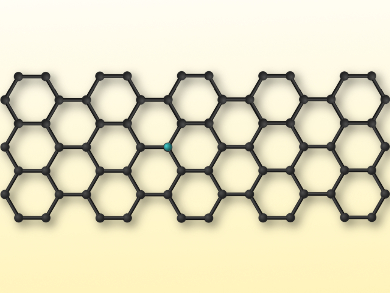Graphene nanoribbons (GNRs) are quasi-1D materials with potential applications in electronics. However, their electronic conductivity is much lower than that of 2D graphene sheets. Tailoring the structure through doping is seen as one way to improve the electrical properties of GNRs. Currently, doping mechanisms in GNRs are not well understood because the conventional doping models used for semiconductor materials are not applicable.
Felix R. Fischer, Steven G. Louie, Michael F. Crommie, University of California and Lawrence Berkeley National Laboratory, Berkeley, USA, and colleagues have studied the effects of boron dopants on the electronic structure of GNRs. The team synthesized GNRs with a maximum width of 7 carbon atoms (pictured) on an Au(111) surface using bottom-up deposition methods. The GNRs were then doped with boron at different concentrations using polymerization and cyclodehydrogenation approaches.
Using density functional theory (DFT) calculations, the team found that the inclusion of boron atoms into the GNRs should induce two sharp dopant electronic states, which vary in energy splitting values depending on the concentration of dopants. However, the observations from scanning tunneling spectroscopy experiments showed slightly different results, in that there were two broad dopant states with much higher energy splitting values than the calculations predicted.
According to the team, this higher energy split can be attributed to a unique hybridization between the dopant’s electronic states and those of the underlying Au(111) surface. The researchers point out that they would expect a very different electronic behavior for boron-doped GNRs placed on substrates other than gold which interact less strongly with boron.
- Concentration Dependence of Dopant Electronic Structure in Bottom-up Graphene Nanoribbons,
Zahra Pedramrazi, Chen Chen, Fangzhou Zhao, Ting Cao, Giang D. Nguyen, Arash A. Omrani, Hsin-Zon Tsai, Ryan R. Cloke, Tomas Marangoni, Daniel J. Rizzo, Trinity Joshi, Christopher Bronner, Won-Woo Choi, Felix R. Fischer, Steven G. Louie, Michael F. Crommie,
Nano Lett. 2018, 18, 3550–3556.
https://doi.org/10.1021/acs.nanolett.8b00651



![Synthesis of [c2]Daisy Chains via Mechanochemistry](https://www.chemistryviews.org/wp-content/uploads/2025/04/202504_RotaxanesWithSolidStateMechanochemistry-125x94.png)
